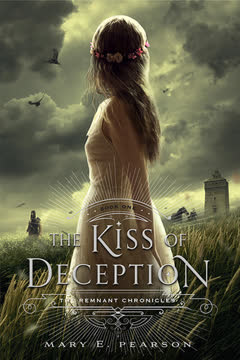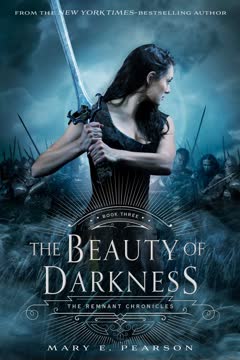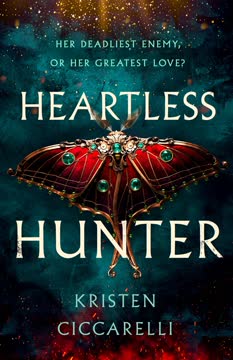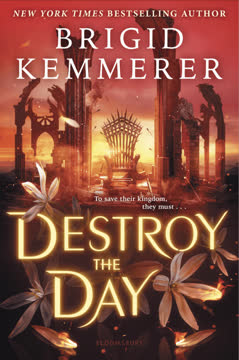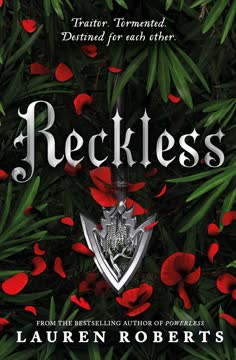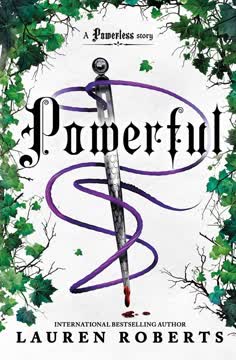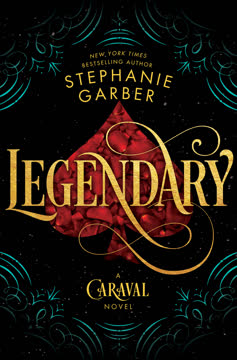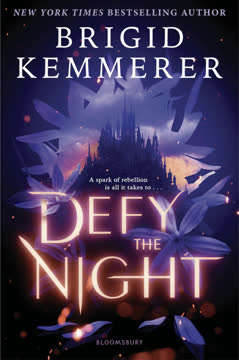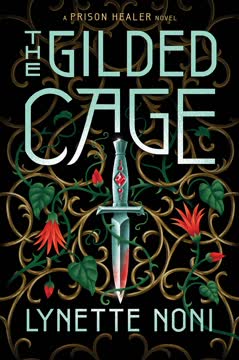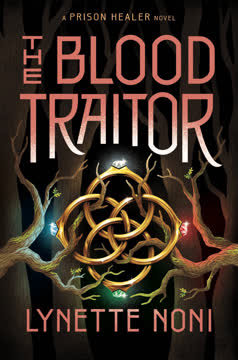Plot Summary
Captives in Enemy Walls
The story opens with Princess Lia and Rafe, both captives, being marched into the heart of the enemy kingdom, Venda. The city is a maze of ruin and menace, its people hungry and suspicious. Lia steels herself, realizing survival will require more than a single act of defiance—she must play a long, dangerous game. The Komizar, Venda's enigmatic and ruthless ruler, is introduced as a master manipulator, immediately establishing his dominance over Lia and Rafe. Lia's grief for her slain brother Walther is raw, but she must hide her pain and fear, knowing any sign of weakness could be fatal. The city's brutality is palpable, and Lia's resolve is tested as she is stripped of dignity and thrust into a world where every move is watched and every word could be her last.
The Komizar's Game
In the grim Sanctum Hall, Lia and Rafe are paraded before the Komizar and his Council. The Komizar toys with them, mocking Lia's royal status and flaunting the spoils of war—her brother's sword and baldrick. Kaden, the Assassin who brought Lia to Venda, is caught between loyalty and guilt. The Komizar's charisma is chilling; he manipulates the room with ease, making clear that both Lia and Rafe are pawns in his larger schemes. Lia's silence is a weapon, but the Komizar's psychological games cut deep, exploiting her grief and isolation. The power dynamics are established: the Komizar is both judge and executioner, and survival depends on playing his game without losing oneself.
Secrets and Survival
Lia and Rafe are separated, each forced to navigate the treacherous politics of Venda. Rafe reveals his true identity as the Prince of Dalbreck, shattering Lia's trust but also deepening their bond. Their reunion is fraught with longing and anger, as both question the other's motives. Kaden's conflicted feelings for Lia surface, complicating loyalties further. The prisoners must construct elaborate lies to stay alive, pretending to be more valuable than they are. Rafe claims to be an emissary with a secret alliance, buying time with the Komizar. Lia, meanwhile, learns that her supposed "gift" is both a threat and a tool, as the superstitious Vendans begin to see her as a sign from the gods.
Reunion in Chains
In a rare moment alone, Lia and Rafe confront the truth of their feelings and the lies that have defined their relationship. Their love is tested by betrayal and the harsh reality of their captivity. Rafe's injuries and Lia's grief draw them together, but the threat of death looms. They plot escape, but the odds are overwhelming. The emotional stakes are heightened as they realize that survival may mean sacrificing their love or their lives. Their alliance is fragile, built on hope and desperation, as they cling to each other in the darkness of Venda's dungeons.
The Assassin's Dilemma
Kaden, torn between his duty to Venda and his feelings for Lia, becomes a pivotal figure. His past is revealed—a bastard son, betrayed by his Morrighese father and saved by the Komizar. Kaden's identity is shaped by pain and a desperate need for belonging. He is both captor and protector, struggling to reconcile his love for Lia with his loyalty to the Komizar. The Komizar manipulates Kaden, using his gratitude and trauma to keep him in line. Kaden's internal conflict is a microcosm of the larger battle between vengeance and mercy, love and duty.
The Gift and the Lie
Lia's supposed "gift"—a mystical intuition—becomes central to her survival. The Komizar wants to exploit it for political gain, while the people of Venda begin to see her as a prophesied figure. Lia must perform, weaving truth and fiction to maintain her value. She is forced to participate in rituals and public displays, her every word scrutinized for signs of divine favor. The line between real power and performance blurs, as Lia discovers that her greatest weapon may be the stories she tells and the hope she inspires. Yet, every lie brings her closer to the edge, as the Komizar's patience wears thin.
Power, Pain, and Politics
The Council of Venda is a nest of vipers, each member jockeying for power and favor. The Komizar's rule is absolute, but dissent simmers beneath the surface. Lia is paraded as a symbol of hope, her presence used to placate the starving masses and the restless governors. The politics of survival are brutal—betrayal is commonplace, and mercy is rare. Lia witnesses the execution of traitors, the mutilation of children for theft, and the casual cruelty of those in power. Yet, she also finds unexpected kindness among the people, especially the children and the clan Meurasi, who welcome her as one of their own.
The People of Venda
As Lia is forced to interact with the common people of Venda, she discovers a world beyond the Komizar's cruelty. The city is filled with hunger, hope, and resilience. Children like Aster, Yvet, and Zekiah become her allies, offering small acts of kindness and moments of connection. The clan Meurasi gifts her a dress of many hands, symbolizing acceptance and unity. Lia's understanding of Venda deepens—she sees not just enemies, but individuals struggling to survive. This empathy becomes both her strength and her vulnerability, as she is drawn into the lives and dreams of those she once called barbarians.
The Council's Shadow
Beneath the city, Lia uncovers a secret army and a network of scholars—traitors from her own kingdom—translating ancient texts for the Komizar. The true scale of Venda's ambitions is revealed: a vast army, new weapons, and a plan to conquer Morrighan and Dalbreck. The Komizar's power is built on secrets, lies, and the manipulation of hope. Lia realizes that her presence is part of a larger prophecy, and that her fate is tied to the destiny of nations. The Council's machinations threaten to consume her, as alliances shift and the line between friend and foe blurs.
The Queen's Gambit
The Komizar announces his intention to marry Lia, turning her into a symbol of unity and conquest. The wedding is a political maneuver, designed to legitimize his rule and rally the clans. Lia is forced to play along, using the marriage to buy time and protect Rafe. The ceremony is set for the rise of Hunter's Moon, and the city is swept into a frenzy of anticipation. Lia's agency is both stripped away and reclaimed, as she navigates the dangerous game of appearances, power, and survival. The marriage becomes a crucible, testing her resolve and her ability to outwit the Komizar.
Blood and Betrayal
As the wedding approaches, tensions boil over. The Komizar's brutality is laid bare when he murders Aster, the child who had become Lia's friend and symbol of hope. In a moment of rage and clarity, Lia kills the Komizar, shattering the illusion of his invincibility. Chaos erupts as the Council and Rahtan descend on the terrace, and a desperate battle for survival ensues. Allies and enemies are revealed in the heat of combat, and the cost of betrayal is paid in blood. Lia's act of violence is both liberation and curse, marking her as both savior and target.
The Army Below
With the Komizar dead, the city descends into chaos. Lia, Rafe, and their allies—revealed to include Rafe's loyal soldiers and unexpected supporters among the Council—fight their way through the catacombs and toward the river. The escape is frantic and bloody, with friends falling and enemies closing in. The raft that promises freedom is a fragile hope, battered by the river's fury and the arrows of pursuers. Lia is wounded, and the line between life and death blurs as she and Rafe are swept into the icy current, clinging to each other and the promise of a future beyond Venda's reach.
The Dress of Many Hands
Throughout her ordeal, Lia's sense of self is transformed. The dress of many hands, gifted by the clan Meurasi, becomes a symbol of her journey from outsider to leader, from pawn to queen. She is shaped by the people she meets, the pain she endures, and the choices she makes. The prophecy of Jezelia—the one marked with claw and vine—becomes her own, as she embraces both her power and her vulnerability. The story is not just of survival, but of becoming: Lia is no longer just a princess or a prisoner, but a force that can change the fate of kingdoms.
The Marriage Bargain
The love triangle between Lia, Rafe, and Kaden reaches its breaking point. Each is forced to confront the limits of loyalty, the meaning of love, and the price of freedom. Lia's marriage to the Komizar is both a sacrifice and a strategy, a means to protect those she loves and to buy time for escape. Rafe's devotion is unwavering, but he must accept that love cannot always save. Kaden's pain is acute, as he realizes that his loyalty to Venda and the Komizar has cost him the one person who saw his true self. The bonds between them are tested, broken, and reforged in the crucible of betrayal and hope.
The Storm Gathers
As Lia uncovers the full extent of the Komizar's plans—a secret army, new weapons, and a campaign of conquest—she realizes that the fate of Morrighan and Dalbreck hangs in the balance. The prophecy of the Song of Venda comes to life, and Lia's role as Jezelia is both a burden and a call to action. The storm of war is gathering, and the choices made in Venda will shape the future of all kingdoms. Lia's escape is not just a personal victory, but the spark of a larger resistance against tyranny and darkness.
The Last Remnant
The escape from Venda is costly—lives are lost, wounds are deep, and the future is uncertain. Lia and Rafe, battered and bleeding, find themselves on the far side of the river, clinging to each other and the hope of a new beginning. The prophecy lingers: sacrifice is not the end, but the beginning of something greater. The story closes with the promise that the remnant—the survivors, the dreamers, the broken and the brave—will endure, and that Lia's journey is far from over.
Sacrifice and Escape
Lia and Rafe, having survived the river and the wrath of Venda, face an uncertain future. Their love, tested by betrayal and loss, is a fragile but enduring flame. The scars of their ordeal are deep, but so is their resolve. The world they return to is changed, and the battles ahead will demand even greater sacrifices. Yet, in each other, they find the strength to hope, to fight, and to believe that even in the heart of betrayal, redemption is possible.
Characters
Lia (Princess Jezelia)
Lia is the First Daughter of Morrighan, whose flight from an arranged marriage sets the entire saga in motion. In Venda, she is transformed from a sheltered princess into a survivor, a leader, and a symbol of hope. Her "gift"—a mystical intuition—becomes both a weapon and a burden, as she learns to wield it in the service of others. Lia's journey is marked by loss, betrayal, and the constant threat of death, but her empathy for the people of Venda and her refusal to be broken define her. Torn between love for Rafe and the complicated loyalty of Kaden, Lia's choices are never easy. Her arc is one of self-discovery, as she claims her agency and embraces the prophecy of Jezelia, becoming both a queen and a catalyst for change.
Rafe (Prince Jaxon Tyrus Rafferty)
Rafe is the crown prince of Dalbreck, initially disguised as a commoner. His pursuit of Lia is driven by both political necessity and genuine love, but his deception wounds her deeply. In Venda, Rafe is forced to play the role of emissary, spinning lies to buy time and protect Lia. His soldier's training and leadership are tested as he navigates the Komizar's deadly games. Rafe's love for Lia is unwavering, but he must accept that love alone cannot save them. His arc is one of sacrifice, patience, and the painful acceptance of loss. Rafe's loyalty to his friends and his kingdom is matched only by his willingness to risk everything for Lia.
Kaden (The Assassin)
Kaden is the Assassin of Venda, a bastard son betrayed by his Morrighese father and saved by the Komizar. His identity is shaped by pain, longing for belonging, and a desperate need for justice. Kaden's feelings for Lia are complex—part love, part guilt, part duty. He is both captor and protector, struggling to reconcile his loyalty to Venda with his growing empathy for Lia. The Komizar manipulates Kaden's trauma, keeping him bound by gratitude and fear. Kaden's arc is one of internal conflict, as he is forced to choose between vengeance and mercy, love and loyalty, ultimately finding the courage to break free from the Komizar's control.
The Komizar
The Komizar is the ruler of Venda, a master manipulator who wields fear and hope with equal skill. He is both a visionary and a tyrant, building a secret army and plotting the conquest of Morrighan and Dalbreck. The Komizar's charm is chilling, his cruelty casual, and his ambition boundless. He exploits Lia's gift, manipulates the Council, and uses marriage as a weapon. His relationship with Kaden is complex—part brotherhood, part ownership. The Komizar's downfall comes from his inability to see the humanity in those he uses, and his death is both a liberation and a warning.
Calantha
Calantha is the daughter of a former Komizar, scarred by violence and betrayal. She serves as a guard and confidante, her loyalty shifting between self-preservation and a longing for justice. Calantha's relationship with Lia is fraught—she is both protector and potential betrayer. Her past with the Komizar and her own acts of vengeance shape her actions. Calantha's arc is one of reclaiming agency, as she ultimately chooses to help Lia escape, breaking the cycle of fear and complicity.
Aster
Aster is a young girl in Venda who befriends Lia, embodying the resilience and vulnerability of the city's people. Her kindness and courage offer Lia moments of humanity amid brutality. Aster's tragic death at the hands of the Komizar is a turning point, shattering Lia's last illusions and catalyzing her final act of rebellion. Aster represents the cost of power and the innocence lost in the struggle for survival.
Griz
Griz is a member of the Rahtan, initially a fearsome enforcer but revealed to have hidden depths. His loyalty to Kaden and, eventually, to Lia, is hard-won. Griz's actions—lying to protect Rafe, fighting alongside the escapees—demonstrate the possibility of change even in the hardest hearts. He is a bridge between the brutality of Venda and the hope for something better.
Pauline
Pauline is Lia's closest friend, left behind in Morrighan but determined to help. Her journey is one of loyalty and heartbreak, as she navigates court intrigue, betrayal, and the revelation of Lia's supposed treason. Pauline's arc is one of endurance, as she holds on to hope and prepares for the battles to come.
Sven, Jeb, Tavish, Orrin
These men risk everything to rescue Rafe and Lia, infiltrating Venda and orchestrating the escape. Their camaraderie, courage, and skills are vital to the plan's success. Each brings a different perspective—Sven's wisdom, Jeb's linguistic talent, Tavish's ingenuity, Orrin's strength. They represent the bonds of friendship and the sacrifices made for loyalty.
The Council of Venda
The Council is a collection of governors, chievdars, and Rahtan, each with their own agendas. Their support is crucial to the Komizar's power, but their loyalty is fickle. The Council's shifting alliances and willingness to betray or support Lia reflect the larger themes of power, fear, and the cost of survival.
Plot Devices
Dual Narratives and Shifting Perspectives
The novel alternates between Lia, Rafe, and Kaden, allowing readers to experience the story's events from different psychological and emotional angles. This structure heightens tension, reveals hidden motives, and creates empathy for even the most conflicted characters. The shifting perspectives also serve to foreshadow betrayals and alliances, as each character's internal struggles mirror the larger conflicts of the story.
Prophecy and the Power of Story
The Song of Venda and the prophecy of Jezelia are central plot devices, shaping characters' actions and the expectations of the people. Lia's "gift" is both literal and metaphorical—a way of knowing, a power of intuition, and a tool for survival. The act of storytelling—public blessings, rituals, and lies—becomes a weapon, as Lia manipulates appearances to inspire hope or deceive enemies. The blurred line between truth and performance is a recurring motif, underscoring the power of narrative to shape reality.
Political Intrigue and Betrayal
The novel is structured around a web of political machinations: the Komizar's manipulation of the Council, the secret army, the marriage plot, and the infiltration by Rafe's soldiers. Betrayal is constant—personal, political, and emotional. Foreshadowing is used to build suspense, as small details (a hidden knife, a whispered promise) become pivotal in moments of crisis. The tension between public duty and private desire is explored through every major character.
Symbolism and Motifs
The dress of many hands, the kavah (claw and vine tattoo), the tether of bones, and the rituals of sacrifice and remembrance are recurring symbols. They represent identity, belonging, and the cost of survival. The river, the bridge, and the city's labyrinthine passages are metaphors for the journey, the barriers between worlds, and the possibility of escape or entrapment. The motif of sacrifice—personal and collective—runs through the narrative, culminating in acts of violence and redemption.
Escalating Stakes and Climactic Confrontation
The narrative structure is carefully paced, with each chapter raising the stakes—emotionally, politically, and physically. The approach of the wedding, the revelation of the secret army, and the murder of Aster all serve as catalysts for the final confrontation. The escape sequence is a masterclass in suspense, with multiple plot threads converging in a desperate bid for freedom. The resolution is both satisfying and open-ended, setting the stage for further conflict and growth.
Analysis
The Heart of Betrayal is more than a tale of captivity and escape; it is a profound exploration of what it means to survive—and to lead—in a world built on lies, violence, and shifting allegiances. Through Lia's journey, the novel interrogates the nature of power: who wields it, who suffers under it, and how it can be reclaimed or subverted. The story's emotional core lies in the tension between love and duty, self and society, vengeance and mercy. Pearson's use of prophecy and myth blurs the line between destiny and choice, suggesting that the stories we tell—about ourselves, our enemies, and our future—can become self-fulfilling. The novel's greatest lesson is that hope is both fragile and fierce: it can be manipulated by tyrants, but it can also inspire resistance and transformation. In the end, Lia's refusal to be defined by her captors, her willingness to sacrifice, and her empathy for even her enemies mark her as a true leader. The Heart of Betrayal challenges readers to consider what they would risk for freedom, love, and the possibility of a better world.
Last updated:
Review Summary
The Heart of Betrayal received mixed reviews, with many praising its improvement over the first book. Readers enjoyed the expanded world-building, character development, and political intrigue. Some found the romance and love triangle compelling, while others felt it detracted from the plot. Critics noted a slow pace and lack of action in the middle, but praised the engaging ending. Overall, fans of YA fantasy found it an entertaining read, though some felt it didn't live up to expectations set by other popular series in the genre.

